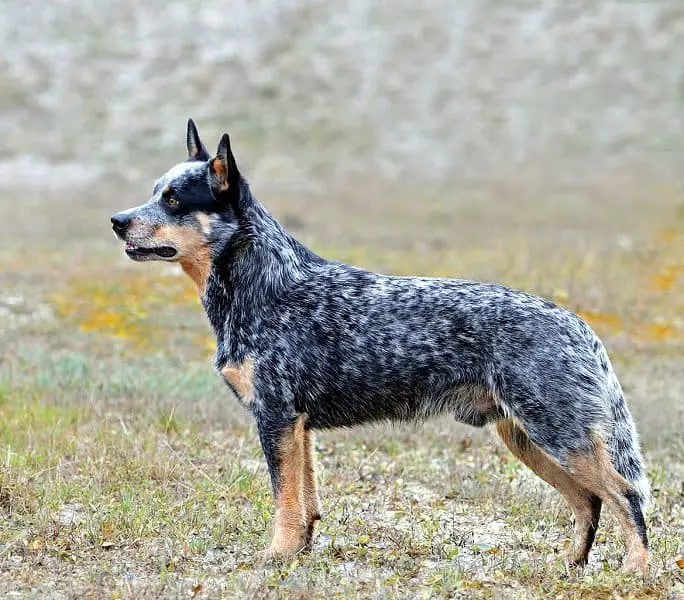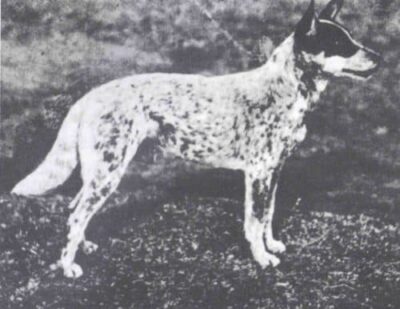- Australian Cattle Dogs are highly energetic and intelligent.
- They have a strong work drive and herding instinct.
- They are known for being independent, confident, and sometimes stubborn.
- They are extremely loyal and protective.
- Australian Cattle Dogs are loving and devoted companions who form strong bonds with their owners.
- They do however require an experienced owner who can provide plenty of exercise, proper training, and ongoing socialization.
Table of Contents
- Australian Cattle Dog Origin
- Australian Cattle Dog Breed Information
- Australian Cattle Dog Breed Description
- Australian Cattle Dog Temperament
- Australian Cattle Dog Health
- Australian Cattle Dog Overweight Problems
- Herding Dogs
- Sports and Activities
- Warning! Australian Cattle Dogs are not for everybody
- Australian Cattle Dogs in Rescue Shelters
- Australian Cattle Dogs-A Trainers viewpoint
Australian Cattle Dog Origin and History
Today’s Australian Cattle Dog breed traces to the early 1800s, the George Hall family, and to the huge, expansive cattle operations of New South Wales and Queensland, Australia, where a courageous, strong-willed companion was needed to herd and move wild cattle.
George Hall and his family migrated to Australia from England in 1802. His son Thomas is credited with crossing local drover dogs with the Australian Dingo in the 1820s to produce the rugged, hardy Hall’s Heeler, that became the Australian Cattle Dog breed that we know today.
We know that the Australian Cattle Dog breed is a descendant of Australia’s wild Dingo. Some information speculates that other ancestors might include the Collie and the Dalmatian, however, there exists no factual evidence of this.
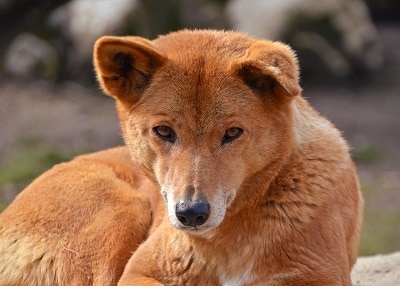
Australian Dingo
Watch for the link to our Australian Cattle Dog breed History Page at the bottom of this article. You will read Author Noreen Clark’s story about the Hall’s Heeler, the involvement of the Hall family, and the true story of their origin.
Australian Cattle Dog Breed Information
A quick look
- Colors: Blue or Red
- Height: 17-20 inches
- Weight: 35-45 pounds
- Life span: 12-15 years
- Body style: Compact, Muscular
- Group: Herding
Australian Cattle Dog Breed General characteristics
- Very high energy
- Alert
- Active
- Brave
- Curious
- Tireless
- Courageous
- Independent
- Tenacious
- Loyal
- Affectionate
- Mouthy
- Intelligent
- Intense
- Playful
- Pushy
- Cautious
- Protective
- Sturdy
- Tough
- Able to leap tall buildings in a single bound (only joking, but really!)

Australian Cattle Dog Breed Description
Color
Australian Cattle Dog puppies are born all white except for possible solid patches either on the face around the eyes, on the ears, or farther back on the body or tail.
After a few weeks, the darker hair, either black or brown, will start to appear throughout the white hairs, giving the look of blue or red, and almost overtake all of the white.
The Adult Australian Cattle Dog can be either red or blue in color. The red or blue appearance comes from the growth of either brown or black hair throughout the white base.
As a result of the darker hair growing in through the white, they have the appearance of being mottled or speckled. Hardly ever are two dogs exactly the same.
They may also have tan hair showing around the face, chest, and under-body.
(We have an article HERE with more explanation and pictures of each color)
Shedding
It is true that they have a double coat, and, some say that the Australian Cattle Dog breed only sheds once or twice a year when he “blows” his fur, however, like most dogs, they shed 24 hours a day, 7 days a week, 52 weeks a year!
It may be true that their winter undercoat sheds in clumps once a year, but, don’t be fooled into thinking that you won’t need your vacuum cleaner anymore.
(See our article HERE on shedding)
An occasional bath or brushing is all that will be necessary to keep your Australian Cattle Dog looking his best.
Height
The Australian Cattle Dog stands an average of 18 to 19 inches tall. This is just a little larger than a Beagle or Cocker Spaniel but a little smaller than a Dalmatian or Collie.
Weight
The average adult Australian Cattle Dog weighs in at around 35-45 pounds and their body style is compact and muscular.
Even though they are about the same height as an American Staffordshire Terrier, they weigh considerably less. (Some American Staffordshire Terriers can weigh as much as 70 pounds.)
Australian Cattle Dog Breed Description
Group
The Australian Cattle Dog breed is a member of what the American Kennel Club calls the Herding Group. Members of the Herding Group were developed and bred over time to help herd, work, gather and to protect livestock, and their owners.
Members of this group show an innate desire to force and control the movement of almost anything that moves. They have been used for over a hundred years to muster cattle on farms and ranches around the world, to move, to separate, to drive and to load rank individuals up ramps into trucks and trailers.
They are VERY GOOD at their job!
This is where Australian Cattle Dogs get their nickname of “Heelers.” They will nip after the rear legs of any uncooperative critter. This desire also comes out in play as they will sometimes mouth your feet while you are playing chase.
It is a good idea for you to pay close attention when they are playing with children, and to put a quick stop to any “kid herding” going on. Make sure they know that they are not the boss of you!
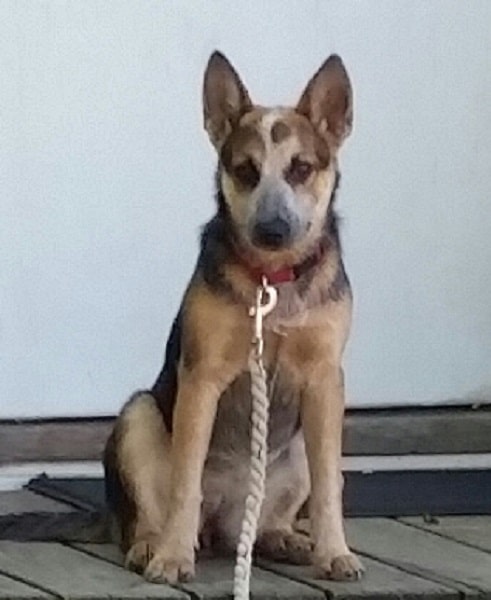
Australian Cattle Dog Temperament
The Australian Cattle Dog breed seems to be able to run and play for hours without tiring. He is an ultra high energy dog who is happiest when he is most active. He will run and catch that Frisbee or ball over and over until you tire of throwing it.
Sometimes their personality can be a bit overwhelming. Especially for a first-time owner, their demand for attention can be draining.
Since the Australian Cattle Dog is so very active, they have a tendency to need not only physical exercise but most importantly, mental stimulation.
Be prepared to spend a lot of your time walking, playing, training and socializing with your Australian Cattle Dog. Without your almost constant supervision he will find ways to entertain himself.
You may not like some of the things he decides to do. Exercise can help prevent a lot of his unwanted behavior.
Although they will be affectionate to the entire family, they are famous for choosing just one person to attach themselves to forever.
Australian Cattle Dogs will be almost obsessed with that one person who he has chosen to be most loyal to, and at times will live up to the characterization of being a “Velcro” dog. That one person may never be alone again.
(See our article HERE on why he can be a good family dog.)
More on Australian Cattle Dog Breed Temperament
Because he is courageous, yet cautious and suspicious of strangers, he can be very protective. He is never afraid to sound the bark alarm should he feel that someone unfamiliar is entering his area.
He can be very suspicious of approaching strangers either human or canine and may feel the need to protect himself. Some individuals may even border on fight rather than flight.
Some Australian Cattle Dogs can be very protective of their own space and growl or bark when they feel invaded. This may be why some are called “dog aggressive.” Just remember that no matter what kind of dog you have, he does not have to be best friends with all other dogs.
The Australian Cattle Dog breed can also be independent at times and may not want to be messed with, but rather, he may prefer to be left alone. This would be a good time to respect his space.
One of the most intelligent, tough, sturdy dogs, The Australian Cattle Dog can learn to participate in a number of activities including herding or sports ranging from hiking, fetching a ball, catching a Frisbee, dock diving, obedience, agility, and extending to IPO/Shutzhund or IGP
Australian Cattle Dog Health
Overall, the Australian Cattle Dog breed is known to be one of the healthiest breeds. Like other dogs in the Working or Herding Groups, they were selectively bred to be active and to thrive in an outdoor environment.
They were bred to work hard and be productive. This gives them an advantage over other breeds that were bred to only look pretty.
There are, however, a few health concerns to be aware of, especially if you are puppy shopping or considering adding an Australian Cattle Dog to your family.
Australian Cattle Dog Genetic Blindness Issues
Blindness: PRCD-PRA
The cells of the retina at the back of an eye are susceptible to degeneration. This degeneration, or atrophy, prevents the light rays from being turned into the electrical signals, which, when sent to the brain, are interpreted as sight.
One type of retinal atrophy happens over time and is said to be progressive. This is progressive retinal atrophy or PRA. Progressive retinal atrophy affects over 100 different breeds of dogs.
There are several types of progressive retinal atrophy involving the structures of the retina called the rods and cones. These are the photoreceptors responsible for the electrical signals that the brain recognizes.
The rods are responsible for vision in low light situations. When they are affected, the dog will undergo what is called night blindness. The cones are more responsible for vision in daylight and, when affected, will cause total blindness.
Progressive Rod-Cone Degeneration or PRCD is when the rods and cones are affected over time, first with the rods and eventually the cones. This will show up as periods of night blindness followed, in time, by total blindness.
PRCD-PRA is a recessive genetic trait. In order for an individual to be affected, he must inherit one gene from each parent. If only one gene is inherited from only one parent, he is said to be a carrier, but will not develop this condition.
The Australian Cattle Dog breed is one of many that can be affected by PRCD-PRA. There is, however, a genetic test to see if a dog carries the gene for this condition. So, if you are looking at a puppy, ask the breeder if this test has been performed on the parents. This will tell you whether or not the puppy is in jeopardy of inheriting the condition.
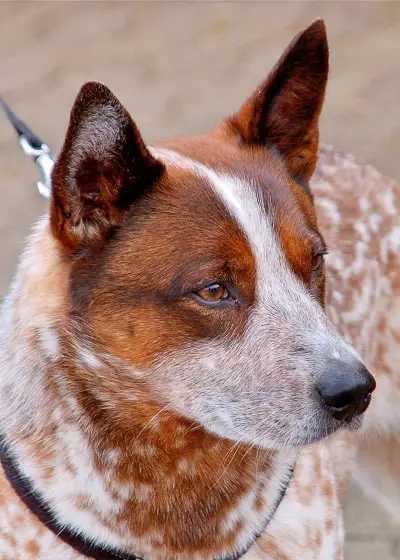
Australian Cattle Dog Genetic Blindness Issues
Blindness: PLL
The lens at the front of the eye is responsible for focusing the light coming through onto the retina at the back of the eye. The lens is held in place by certain connective tissues located in a circle all around the outside edge. Sometimes these connective tissues will become weak, due to a genetic defect, and allow the lens to fall out of place, or luxate.
This condition is known as Primary Lens Luxation or PLL.
Primary Lens Luxation is also a recessive genetic trait. Source.
Although PLL is genetic, there have been cases of lens luxations that are not PLL caused. These may be due to infection, injury, or possibly some other eye disorder.
In addition to the Australian Cattle Dog, there are at least 25 other dog breeds known to be affected by PLL.
Different laboratories offer DNA testing for PLL.
Australian Cattle Dog Genetic Issues
Degenerative Myelopathy: DM
“Degenerative Myelopathy is a fatal, slowly progressing neurodegenerative disease with a late-onset (age 8 years or older). The initial clinical sign is characterized by spastic and general proprioceptive ataxia of the hind limbs. As the disease progresses, the frequently observed asymmetric weakness ascends to affect the thoracic limbs, resulting in paraplegia”. Eva Holderegger Walser
DM is similar to Lou Gehrig’s Disease found in humans. It is a slowly progressive disease affecting the spinal cord of older adult dogs. DM results in hind limb weakness and finally paralysis. Source.
Although DM affects many different breeds of dogs, it is most commonly associated with the German Shepherd and the Pembroke Welsh Corgi.
Degenerative Myelopathy is inherited in a recessive genetic manner. There is a DNA test to predict which dogs might be at risk of developing the disease or which ones might be potential carriers.
Australian Cattle Dog Genetic Deafness Issues
Deafness:
The inability to hear sounds may be either present at birth or acquired later in life. If it is present at birth it could be either inherited or a result of some type of damage during the development of the unborn puppy.
Inherited deafness: CHSD
CHSD or Congenital Hereditary Sensorineural Deafness affects many dog breeds, including the Australian Cattle Dog. It is inherited as a recessive trait similar to PRCD-PRA. This means that a dog can be a carrier of the gene, having only received one gene from a single parent, and not show any signs himself.
An individual who inherits one gene from each parent will exhibit signs of deafness. SOURCE 1 SOURCE 2
There does seem to be some sort of connection between the color white and inherited deafness. Some breeds, like Dalmatians, that are predominately white, show a higher occurrence of deafness.
There is a test that can be performed on an individual to identify those that are deaf. The BAER test (brainstem auditory evoked response) measures electrical activity in the inner ear and accurately identifies which ear has hearing. SOURCE
Some breeders have had their dogs tested and can give you helpful information about their puppies’ hearing.
Australian Cattle Dog Genetic Issues
Hip Dysplasia:
Sometimes during growth, a deformity occurs between the ball portion of the joint and the socket portion. As the condition worsens, a deterioration of the cartilage can develop resulting in a loose fit within the joint.
This deterioration will usually result in varying degrees of discomfort and pain.
The cause of hip dysplasia can be either genetic or environmental, or a combination of both.
No genetic test exists to determine who may or may not develop the condition.
Although it usually occurs more often in the larger breeds, no breed of dog is immune to the problem.
A veterinarian can easily diagnose this condition with a physical examination which may include x-rays.
A reputable breeder will pay close attention to only using breeding stock that has a low possibility of carrying any predisposition for hip dysplasia.

The Australian Cattle Dog breed is Subject to Overweight Problems
Not that other dog breeds are not also subject to being overweight, but it seems that some of the Australian Cattle Dog breed are even more so. Maybe it’s because they are so active when they are growing that they can burn off any extra calories.
But then, when they mature and settle down a little, they continue to be fed at that higher level. Every bit of excess intake goes directly to stored energy, FAT.
Since their frame is on the medium to smaller size (compared to German Shepherds or Labradors) a little excess weight goes a long way in plumping out that body!
Being overweight puts a tremendous strain on many different bodily systems, including the heart, lungs, hips, ligaments and bone structure.
Please follow your veterinarian’s recommendations concerning diet and exercise to maintain maximum health.
Almost any reputable commercial dog food should be fine. Remember, it is not so much what they eat, but rather how much they eat that causes weight gain.
The Australian Cattle Dog is a member of the Herding Dog group
Australian Cattle Dogs, like other members of the Herding Group, have an innate desire and ability to control the movement of animals, toys, children, or pretty much anything that moves!
In addition to the Australian Cattle Dog breed, some of the better-known members of the Herding Group include the Australian Shepherd, Collies, Belgian Malinois, Border Collies, German Shepherds, Shelties, and Old English Sheepdogs.
Today, the Belgian Malinois and German Shepherd are widely used for protection and police work.
Dogs in this group are all very active and know what it is like to work for a living.
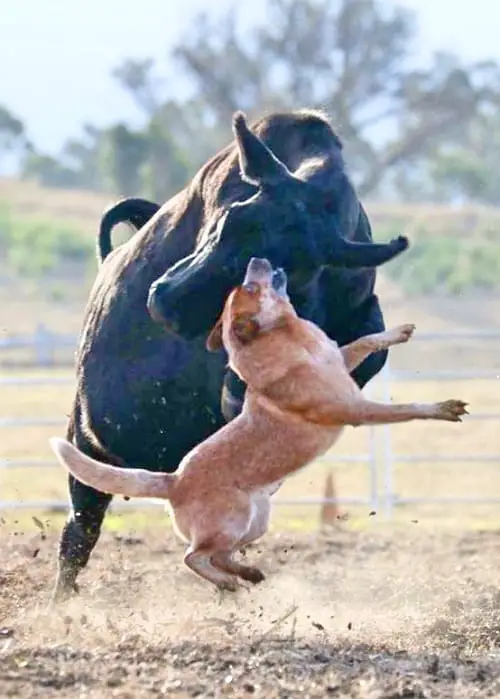
Willowpark Whiz Kid, (Pria), displaying her courage during herding.
Image Credit: Belinda Carter, Erudite Australian Cattle Dogs
Here is a very informative 15-minute video showing the difference between the Australian Cattle Dog breed and the Border Collie and the job each was developed to do. Thanks to Dogumentary TV
Sports and Activities for Australian Cattle Dogs
Australian Cattle Dogs are very athletic, high energy, easy to train and can excel in many different sports and activities. Participating in sports with your dog is a good way for him to get physical exercise and mental stimulation. It is also a great way to build a bond between the two of you.
Just a few that you might try are:
- Herding
- Agility
- Obedience
- Tracking or Scent Work
- Frisbee or Disc
- Dock Diving
Warning: Australian Cattle Dogs are not for everybody!
A recent questionnaire of current cattle dog owners asked, “Why did you choose an Australian Cattle Dog?” With over 600 responses, the answers revealed some interesting information.
- 25% of respondents indicated that they already knew a lot about the Australian Cattle Dog breed. Either a friend or family member had one and they were familiar with most breed characteristics. Almost all of these were repeat owners. Here are the characteristics that these owners were looking for, in order of importance:
- The number one characteristic that owners were specifically looking for was a very active dog to enjoy the outdoors with.
- Second, most were looking for a very loyal dog that would be their friend and companion.
- Thirdly, they wanted a very intelligent dog that they could spend time training for a variety of activities.
- 22% Said that they got their cattle dog at a Rescue Shelter. That is a huge number of Australian Cattle Dogs coming out of shelters. (The obvious question is, why were so many of them in the rescue in the first place?)
- 12% said that they just saw his face, fell in love, and couldn’t resist.
Why are so many Australian Cattle Dogs found in rescue shelters?
Many of the characteristics of the Australian Cattle Dog that are so much loved by most owners can cause great stress to someone who is not prepared to handle their extreme personality.
Does this mean that if you have one you need to have a professional trainer on speed-dial?
No, (well, maybe for a while) but, know that this dog is much more intense than most, and some traits that all dogs have in common are magnified in this breed.
If they weren’t intense and tenacious, they wouldn’t be able to handle cattle the way they do. So, for example, when a small lap dog might quietly ask to go outside, the Australian Cattle Dog will DEMAND to go outside!
You really need to have a certain skill set that allows you to be their leader. If you are the type of person to just sit back and not be able to take charge, then, this dog might not be for you.
If you currently have one, are at your wit’s end, and are desperately looking for help, please, before you consider giving him to a shelter, GET HELP!
Find a good trainer with a long successful track record of proven results. One who understands the Australian Cattle Dog breed.
Your dog deserves no less.
The trainer’s job is to teach you to train your own dog, so you need to be able to learn as much as the dog. Not only does the trainer have to be a good fit for your dog, but the trainer has to be a good fit for you.
Find a trainer who can show real results. One who can confidently say he or she can get your dog totally off-leash trained in about 5-6 weeks.
If it doesn’t work in that amount of time, find another trainer.
Check Out Our Australian Cattle Dog History Page Here
